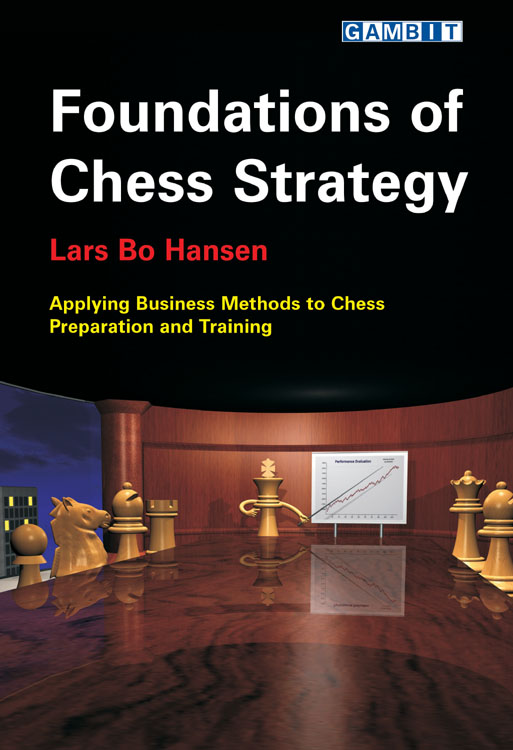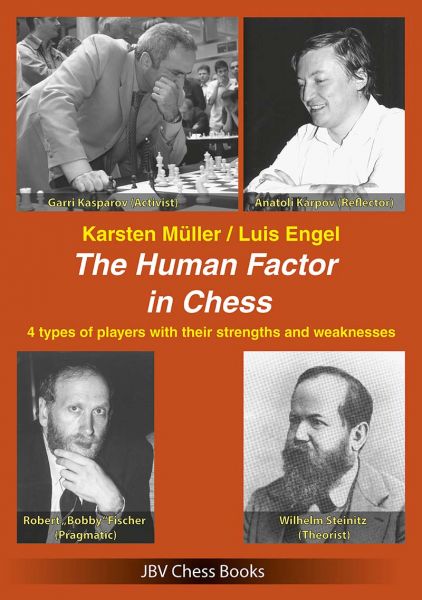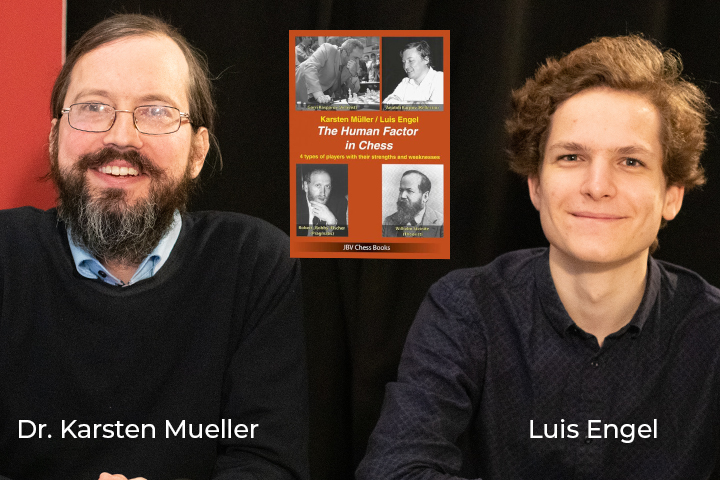A review
By Professor Barry Hymer
As someone who has had a lifelong professional interest in and scepticism about the value of ‘learning styles’ approaches (or their family variants, like ‘player types’), and who has even penned a savage takedown of their value in the chess world — see my blog entry at Chessable — I was intrigued to read The Human Factor in Chess by Karsten Müller and his fellow GM, Luis Engel.
 The title alone made me wonder if there’d be any similarities with one of my all-time favourite chess books, Fred Reinfeld’s The Human Side of Chess, from 1953 (Faber & Faber). There weren’t many, at least in terms of the book’s aims. Almost as prolific as Reinfeld, but with an even more consistent output in terms of quality, Müller’s stellar reputation as a chess writer and theorist needs little by way of introduction of course, and I was worried that my high regard for his work wouldn’t survive this foray into the fascinating but theoretically questionable and fundamentally untestable world of ‘learning styles’. In particular, would I encounter facile conflations of playing styles (a chess player’s habitual preference for playing certain types of positions — and not just won ones — and in certain types of ways) with assumptions that these are built on certain supposedly innate and immoveable qualities or predispositions? Turns out F. Scott Fitzgerald was right, and it’s quite possible to hold two opposing ideas in mind at the same time, and still function. At least it is in the hands of first-rate minds and authors like these.
The title alone made me wonder if there’d be any similarities with one of my all-time favourite chess books, Fred Reinfeld’s The Human Side of Chess, from 1953 (Faber & Faber). There weren’t many, at least in terms of the book’s aims. Almost as prolific as Reinfeld, but with an even more consistent output in terms of quality, Müller’s stellar reputation as a chess writer and theorist needs little by way of introduction of course, and I was worried that my high regard for his work wouldn’t survive this foray into the fascinating but theoretically questionable and fundamentally untestable world of ‘learning styles’. In particular, would I encounter facile conflations of playing styles (a chess player’s habitual preference for playing certain types of positions — and not just won ones — and in certain types of ways) with assumptions that these are built on certain supposedly innate and immoveable qualities or predispositions? Turns out F. Scott Fitzgerald was right, and it’s quite possible to hold two opposing ideas in mind at the same time, and still function. At least it is in the hands of first-rate minds and authors like these.
 First things first. The book builds on the classification of player types introduced by Lars Bo Hansen in his book Foundations of Chess Strategy (Gambit, 2005). Though there are some divergences from the Hansen book in the attribution of individual players from chess history to certain categories, both books posit the existence of four player types: activist, theorist, reflector and pragmatic. Having acknowledged that this won’t be the only possible model, and ‘stereotyped’ or overly dogmatic thinking inevitably brings dangers with it, the suggestion is made (endorsed by Vincent Keymer in his preface) that knowledge of one’s own and one’s opponent’s typology can be helpful in terms of game preparation and self-knowledge. Strengths and weaknesses of each type are outlined, with suggestions for leveraging one’s own strengths whilst exploiting one’s opponent’s weaknesses — in a manner analogous to the old game rock, paper, scissors: e.g. reflectors’ mastery of prophylaxis can trump activists, who in turn can use their knowledge of sharp opening lines to discombobulate both reflectors and theorists, who in turn can aim for quiet, technical positions in order to frustrate calculation-loving pragmatists.
First things first. The book builds on the classification of player types introduced by Lars Bo Hansen in his book Foundations of Chess Strategy (Gambit, 2005). Though there are some divergences from the Hansen book in the attribution of individual players from chess history to certain categories, both books posit the existence of four player types: activist, theorist, reflector and pragmatic. Having acknowledged that this won’t be the only possible model, and ‘stereotyped’ or overly dogmatic thinking inevitably brings dangers with it, the suggestion is made (endorsed by Vincent Keymer in his preface) that knowledge of one’s own and one’s opponent’s typology can be helpful in terms of game preparation and self-knowledge. Strengths and weaknesses of each type are outlined, with suggestions for leveraging one’s own strengths whilst exploiting one’s opponent’s weaknesses — in a manner analogous to the old game rock, paper, scissors: e.g. reflectors’ mastery of prophylaxis can trump activists, who in turn can use their knowledge of sharp opening lines to discombobulate both reflectors and theorists, who in turn can aim for quiet, technical positions in order to frustrate calculation-loving pragmatists.
It’s not an exact science of course, and it’s arguable whether it’s a science at all, but it’s no less fun and fascinating for that. The argument has considerable face-validity, however thin the theoretical base and legion of players who straddle more than one type — or perhaps even none. As a rough-and-ready heuristic for conceptualising player-types, I believe it is both interesting and plausible, and it provides a helpful architecture for a player’s long-term journey towards a universal playing style (a goal acknowledged as such by the authors). Who, after all, doesn’t want to have a Botvinnik-like mastery of general principles, a dash of Smyslovian harmony and a dollop of Fischer-like pragmatism combined with an Alekhinian feel for the initiative? Come to think of it, just one of those qualities would be attractive to us amateurs!
 The book is stronger for the authors’ decision to keep the theoretical overview light-touch, succinct and on-point. It recognises the dynamic evolution of many players’ styles (the early styles of Steinitz, Smyslov and Tal, for instance, provide few clues to their later iterations), and for the most part it avoids assertions that are overly deterministic and mystical — though there are occasional lapses such as the unreferenced assertion that when it comes to “…a feeling for harmony and coordination like that of Karpov or Carlsen, you just have it, or you don’t” (p.99). I’d put good money on the likelihood that these sublime qualities didn’t appear fully formed, but developed cumulatively over time. (By way of evidence, there are many early games of both these legends which are distinctly lacking in these qualities, as well of course many games in which they are replete).
The book is stronger for the authors’ decision to keep the theoretical overview light-touch, succinct and on-point. It recognises the dynamic evolution of many players’ styles (the early styles of Steinitz, Smyslov and Tal, for instance, provide few clues to their later iterations), and for the most part it avoids assertions that are overly deterministic and mystical — though there are occasional lapses such as the unreferenced assertion that when it comes to “…a feeling for harmony and coordination like that of Karpov or Carlsen, you just have it, or you don’t” (p.99). I’d put good money on the likelihood that these sublime qualities didn’t appear fully formed, but developed cumulatively over time. (By way of evidence, there are many early games of both these legends which are distinctly lacking in these qualities, as well of course many games in which they are replete).
But for me the book’s standout strength is when the authors revert to type and do what they excel at: harnessing a lifetime’s love for and high-level expertise in the game in the form of carefully harvested and well-curated positions and exercises, powerfully and lucidly structured and annotated. Typologies provide the architecture for this assemblage, and for obvious reasons examples are included which serve to support the designations of particular players to particular types. No-one investing the time in working through these exercises can fail to benefit, and derive a huge amount of pleasure en passant — whatever their own player-type!
And in terms of publication quality, the occasional translation infelicity aside, the impressive accuracy and visual attractiveness of the book comes as Joachim Beyer Verlag standard.
 Professor Barry Hymer has authored or co-authored ten books and numerous papers and articles in the field of learning and teaching, and his eleventh book is the acclaimed Chess Improvement – It’s all in the mindset (co-authored with Grandmaster Peter Wells).
Professor Barry Hymer has authored or co-authored ten books and numerous papers and articles in the field of learning and teaching, and his eleventh book is the acclaimed Chess Improvement – It’s all in the mindset (co-authored with Grandmaster Peter Wells).
A commitment to evidence-led, situated and non-deterministic approaches to education underpins Barry’s research foci, and his writing, teaching and in-service presentations. He eschews quick educational fixes and decontextualised, externally-imposed ‘solutions’ in favour of attention to learner agency (teacher and student) and a focus on deep and surface learning (mastery leading to performance).
Official website
Playing styles in chess are an important and thus often discussed topic. GM Dr. Karsten Müller and GM Luis Engel take up a model by GM Lars Bo Hansen based on 4 player types - namely ‘activists’, ‘pragmatics’, ‘theoreticians’ and so-called ‘reflectors’.
Links


















 The title alone made me wonder if there’d be any similarities with one of my all-time favourite chess books, Fred Reinfeld’s
The title alone made me wonder if there’d be any similarities with one of my all-time favourite chess books, Fred Reinfeld’s  First things first. The book builds on the classification of player types introduced by Lars Bo Hansen in his book
First things first. The book builds on the classification of player types introduced by Lars Bo Hansen in his book  The book is stronger for the authors’ decision to keep the theoretical overview light-touch, succinct and on-point. It recognises the dynamic evolution of many players’ styles (the early styles of Steinitz, Smyslov and Tal, for instance, provide few clues to their later iterations), and for the most part it avoids assertions that are overly deterministic and mystical — though there are occasional lapses such as the unreferenced assertion that when it comes to “…a feeling for harmony and coordination like that of Karpov or Carlsen, you just have it, or you don’t” (p.99). I’d put good money on the likelihood that these sublime qualities didn’t appear fully formed, but developed cumulatively over time. (By way of evidence, there are many early games of both these legends which are distinctly lacking in these qualities, as well of course many games in which they are replete).
The book is stronger for the authors’ decision to keep the theoretical overview light-touch, succinct and on-point. It recognises the dynamic evolution of many players’ styles (the early styles of Steinitz, Smyslov and Tal, for instance, provide few clues to their later iterations), and for the most part it avoids assertions that are overly deterministic and mystical — though there are occasional lapses such as the unreferenced assertion that when it comes to “…a feeling for harmony and coordination like that of Karpov or Carlsen, you just have it, or you don’t” (p.99). I’d put good money on the likelihood that these sublime qualities didn’t appear fully formed, but developed cumulatively over time. (By way of evidence, there are many early games of both these legends which are distinctly lacking in these qualities, as well of course many games in which they are replete). Professor Barry Hymer has authored or co-authored ten books and numerous papers and articles in the field of learning and teaching, and his eleventh book is the acclaimed
Professor Barry Hymer has authored or co-authored ten books and numerous papers and articles in the field of learning and teaching, and his eleventh book is the acclaimed 




